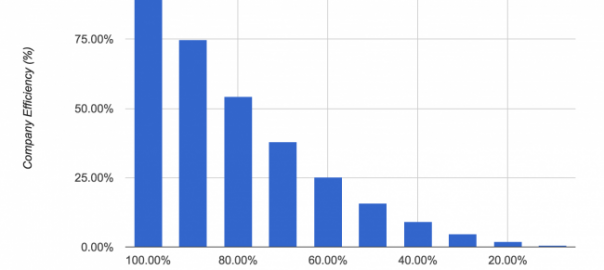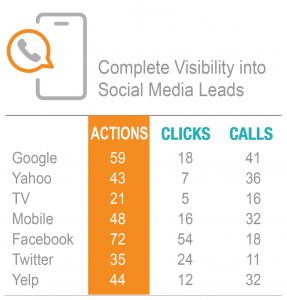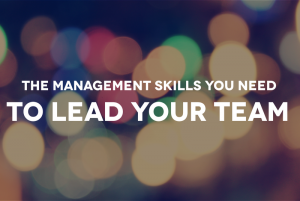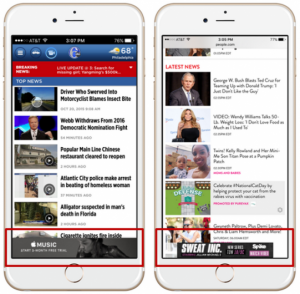It’s easy to say you need great onboarding. It’s more difficult in reality. On top of that, it’s easy for growing companies to push an onboarding strategy low on the list of priorities.
This can be a fatal mistake. Bad onboarding can have lasting repercussions that continue to have a negative impact on your company for years. But great onboarding can have the opposite effect, providing a solid foundation that your company will build on for years to come. Therefore implementing, and then constantly improving, an effective onboarding process for your organization is paramount.
This is especially true of Sales Development Reps, SDRs, as they are such an integral part of your sales process. Without good SDRs you have no pipeline, no opportunities, no deals, no revenue, no growth.
Here’s why bad onboarding compounds, and what a great onboarding strategy looks like.
When Bad Onboarding Attacks
So why is bad onboarding such a killer for a company? It’s because it decreases standards, making reps less effective and increases ramp time, costing the business revenue.
Declining Standards
Without a defined onboarding process in place, ad-hoc mechanisms will be used instead. These might work to start, but as more and more people join your company, bad onboarding compounds.
This causes you to become very inefficient, very quickly. As an example, let’s look at what happens after three rounds of hiring, with five people in each intake. In this scenario, the previous intake are responsible for onboarding the new hires. This is exactly what happens in companies without a process in place.
If it’s a magical unicorn-like company with 100% effective onboarding, then after the three rounds of hires there would be 155 people at the organization, and it would be 100% efficient.
But what happens if the onboarding process is only 90% effective? Then after the three rounds, the combined effectiveness of all the people in the organization only equates to 115 fully-efficient people. That means that company is running at less that 75% efficiency.
Total Productive People After 3 Rounds of Hiring
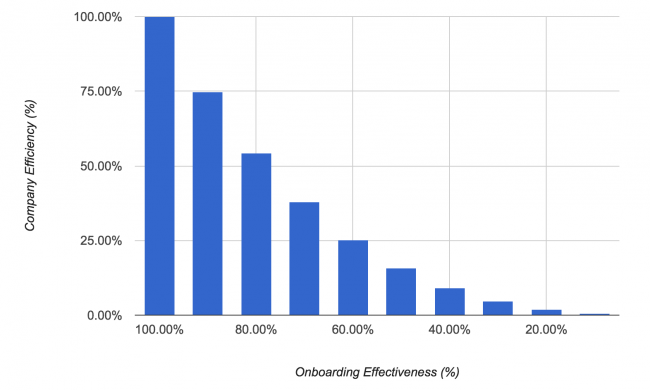
That drop-off is steep. With 60% onboarding effectiveness, efficiency in the organization can be as low as 25%. This is what happens when badly trained people train people badly.
Extending Costs
Efficiency impacts revenue which impacts growth. When we talked about hiring new sales reps, we showed the “cash trough” that each new rep starts with. They are cashflow negative until they are fully ramped and start to close deals.
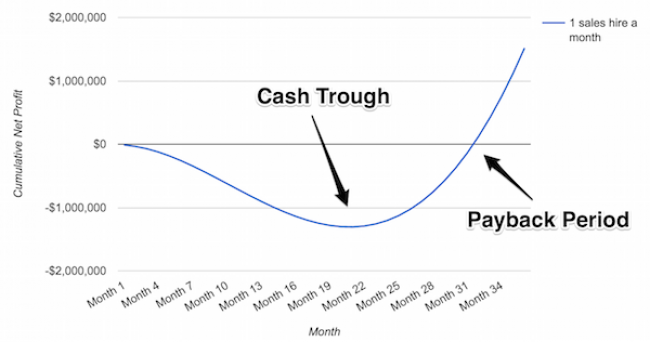
Source: Should I Hire A New Sales Rep?
The same is true of BDRs. While they are learning, a company is investing in them. The quicker that investment pays off and they start contributing fully to the pipeline and revenue, the better for rep and company both.
Bad onboarding extends this period. It will take longer to fully ramp reps up to profitability, and therefore deepen and lengthen this trough:
Lengthened Cash Trough from Bad Onboarding
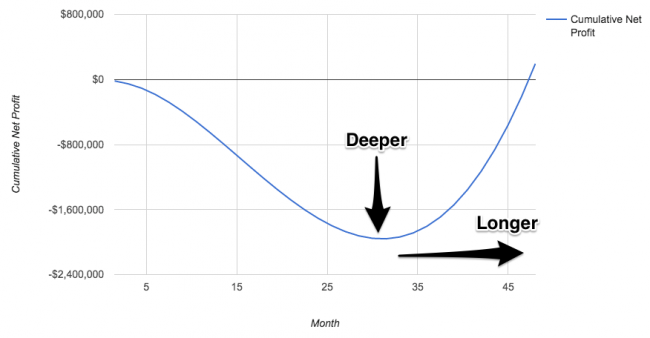
Of course, these two issues don’t happen in isolation. Bad onboarding for your first hires leads to a slightly deeper and longer cash trough. But then when they onboard the next round, they teach further bad habits. The 2nd round then have an even worse cash trough, and so on, with each new generation compounding the problems of the previous one.
When BDRs are onboarding unsuccessfully, the problem propagates. Because they are at the top of the pipeline, if they are doing their job badly, AEs don’t get the leads they need. Even if they are fantastic at their job, and were beautifully onboarded, they will still be at less than peak efficiency because of stoppages further up the pipe.
This is unsustainable.
The Right Way To Onboard
At InsightSquared, we want to get new SDRs ramped up quickly, but we also want to do it effectively. SDRs usually want to hit the ground running, but it is up to us guide them through training . This gives them the tools to succeed not only today, but for years to come.
This training journey starts with the InsightSquared New Hire Playbook. Every new SDR hire gets a copy, telling them on day one what is required of them and how the training is set out.
Page one shows the three things that are expected of any new sales hire:
- Ask questions. We know new hires don’t know anything, so it’s important they understand that they are here to learn.
- Focus on growth. For the training to succeed, the new reps have to be open to learning and personal growth throughout their careers.
- Own your numbers. An important part of any sales process is personal accountability. Telling new hires that they have responsibilities straight away sets the right expectations for their time at InsightSquared.
The playbook then follows five distinct areas of training as the reps ramp up their knowledge and abilities.
1. Teach About Your Audience
Before you get to your product or any thoughts of prospecting, you need to teach incoming BDRs about who their target audience will be. This means:
- Companies: We have a very specific idea of the companies that can benefit from InsightSquared. Narrowing the focus for new hires means they can learn about a specific subset of an industry and master the right knowledge for those customers.
- Personas: Who are the people within those companies that your SDRs are going to be reaching out to? SDRs need to know the responsibilities of these key individuals. More importantly, SDRs need to know the major challenges they are facing so that they can propose exactly the right solution.
- Influencers: Finally, teaching BDRs about the key stakeholders beyond their target personas allows them to understand the buying processes in target organizations. The more they understand the people making decisions, the better they can drill down onto the exact solutions any one target company will need.
The goal of this section of our playbook is to help new hires understand who our buyers are, what their goals are, what challenges they experience, and ultimately, why they buy our software.
2. Teach About Your Strategy
Once they know about their customers, it’s time to introduce them to your team. This means the way your sales team is structured, the particular sales approaches you use, and your particular processes and workflows.
Because the best sales come from a well-defined process, teaching this process early on gives SDRs the time they need to understand their role and how the entire machine operates together.
Here are some questions that your BDRs will need answering to understand how you work:
- How is your team split? How are they going to work together? Setting out for the new BDR who they will be working with each day helps them get oriented within the team.
- Are you using a lead-based inbound strategy or an account-based marketing strategy? Fresh SDRs might not even know different strategies exist. Show them how they are supposed to generate leads and prepare them for AEs according to different sales and marketing strategies.
- Who owns which accounts? If you’re an inside sales team then you probably have named accounts. If field-based, then each sales person might be responsible for different geographic territories. Delineating how accounts are managed helps new hires quickly understand the workflow.
At InsightSquared, this part of the training ends with the new hires starting to prepare themselves to be on a steady process of pulling in new accounts every week, cleaning those accounts, and reaching out to book meetings.
3. Teach About Your Culture
The culture can be highly different from one company to the next, and even from one team to the next. But for SDRs, there is one consistent cultural trait that they will always want to see: growth.
Growth potential is the number one priority for most SDRs. SDR is often the entry-level role in sales, and any good SDR will be looking for their pathway to AE. They will want to learn and want to succeed. They will expect any good company to help them do that.
At InsightSquared we aggressively promote from within. Our BDR team today is where we expect to find out AE team of tomorrow. We want to teach new BDR hires exactly that. This way, they know that if they perform to their maximum, they have a future with the company.
4. Teach About Your Product
Before they can find out how to sell, they need to find out what to sell. SDRs can’t help target customers with their problems unless they know how your product solves them.
Before putting them on the phone, give them a chance to use the product. Allow them time to sit down with a product person and walk through how it works. Give them the time to talk to engineers, product people, and other sales reps to get all the information they need.
Giving them this time will not only boost their confidence when they do get to reach out to customers, but also means that they will have a higher success rate when they do.
Another important part of this area of training is the competition. SDRs should know as much about what your competitor’s product is capable of as they do your own. The challenges they are going to come across are often going to be the X vs Y type. Every day they are going to be asked, “Why should we pick you?”
Giving them a chance to learn about the other products in your space means they can answer these challenges with confidence.
5. Teach About Your Techniques
It’s only at this final point that SDRs should start to learn about the art and science of selling. Again, this will change with company, strategy, and role, but for SDRs it will probably come down to four core competencies:
- Phone aptitude
- Prospecting strategy and ability
- Time Management
- CRM proficiency
Simplicity is key to an effective training program. Too much and the new hire won’t be able to take everything, reducing their ability to eventually do their job.
This is about building a foundation. Any good SDR is going to want this sales training to be continual. Therefore, you don’t have to include every morsel of knowledge on the first day. Instead, give them what they need to get the confidence to reach out, and then build on this day in, day out through training sessions and real-world experience.
The Goal of Onboarding
Onboarding shouldn’t be seen as a hump to get over before you can put your new SDR on the phone. It should be seen as an investment in the future. Spending time here will generate massive returns for the future.
A badly onboarded SDR will cost the company money, be unable to prospect effectively, drag down the current culture, and impact the ability of future hires.
A well-onboarded BDR will know everything about your customers, everything about your product, and everything about your team and strategy. They will then hit the phones with confidence they can help solve every problem and answer any challenge posed. Not only that, but you’ll have a great AE-in-training, and someone who will be a great leader and coach for future SDR generations.
Business & Finance Articles on Business 2 Community(106)
